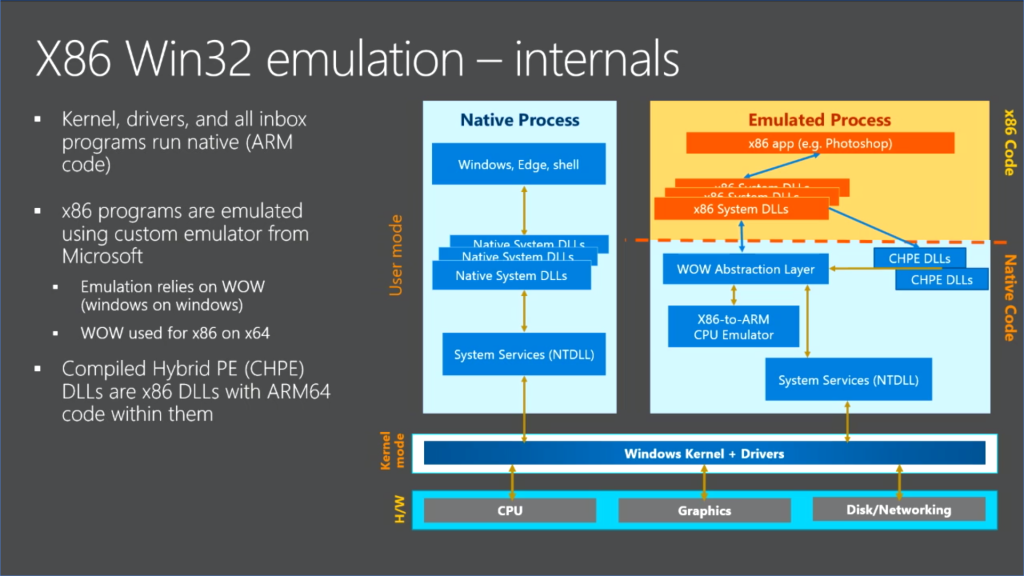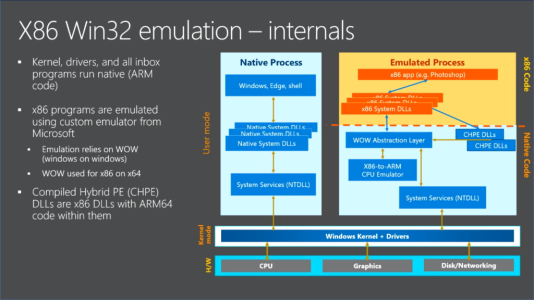Drael646464
New member
- Apr 2, 2017
- 2,219
- 0
- 0
Worth remembering that WoW is an emulation (running 32 bit windows applications on a 64 bit windows OS). And this specifically runs only win32, on a 64 bit chip.
When they first demo'd it the QUALCOMM person said it was running on an unmodified chip. (820 I believe). I don't think there is any hardware component.
What sort of Hardware support do you think is involved? Other than the CPU (835) the RAM and nice compact board with its components, what else is there involved? some sort of turbo device?? What could that be? or another CPU involved in brute force processing? I cant think of what other Hardware we could be talking about?The idea that near native performance while performing on-the-fly ISA translation is possible without any hardware support is equally ridiculous.
Yes, I know. However, Qualcomm and MS had already been working on the technology for quite some time at that point. Whatever MS is using for ISA translation was already available in the SD820. For some unknown it reason it apparently just wasn't yet good enough.
You are of course free to believe whatever you want to believe. However, assuming MS' claim of near native performance is true (which is yet unproven), then you might as well believe people can fall upward. The idea that near native performance, while performing on-the-fly ISA translation, is possible without any hardware support is equally ridiculous.
What sort of Hardware support do you think is involved? Other than the CPU (835) the RAM and nice compact board with its components, what else is there involved? some sort of turbo device?? What could that be? or another CPU involved in brute force processing? I cant think of what other Hardware we could be talking about?
If you look at the system requirements for these Win32 applications they will run happily on a 10 year old PC so a modern SD835 should have no issue.
If you want to see it the other way take a look at AMI DuOS that runs ARM Android apps on the fly on X86 Windows.
*Facepalm*
If there was no ISA translation involved, sure. There is. Emulating a 4W mobile CPU on a 45W desktop CPU is also a completely borked analogy. Completely different situation.
What ever a Dynamic binary Translator is, it seems to be the key part to this, it "looks at chunks of Code and translates them to blocks of ARM 64 code at run time".
Exactly. If you can dig up anything on that anywhere then please let us know! ;-)
What ever a Dynamic binary Translator is, it seems to be the key part to this, it "looks at chunks of Code and translates them to blocks of ARM 64 code at run time".
The Baytrail Atom is not 45W processor.
What MS are doing sounds like a modern implementation of the old FX!32 that DEC came up with in the early 90's.
That actually sounds like a plausible way of achieving "near native speeds" using only software. And it sounds quite a bit like MSFTs language around the emulation layer. too.
I agree that it would be the most straight forward way to achieve near native speeds. I disagree that it sounds like what MS has so far described. Admittedly, that hasn't been much, but from everything I've read it sounds to me like the opposite. To me it sounds like what MS is describing is on-the-fly ISA translation at runtime.
Do you have anything specific that would lead you to conclude otherwise? I certainly would be interested if you do.


Somehow its those CHPE binaries/dll's that do the grunt work, and make it so that its not actually on the fly. Which I suppose isn't exactly like FX!32. Those DLLS work with WoW and some kind of chipset emulation to produce the total effect.

